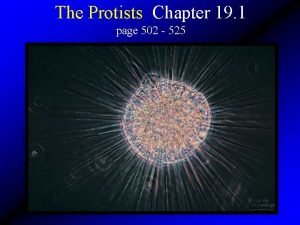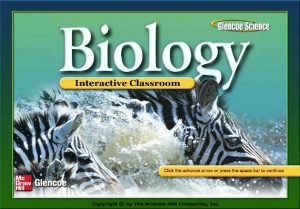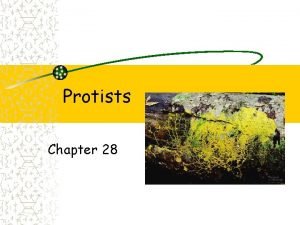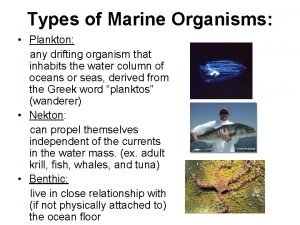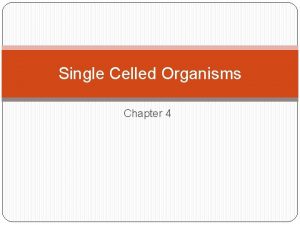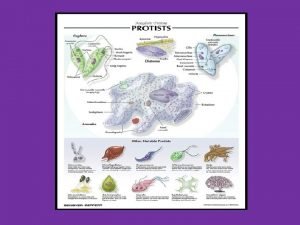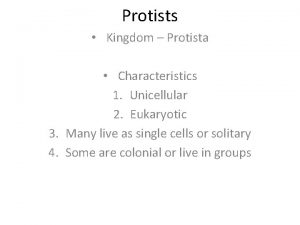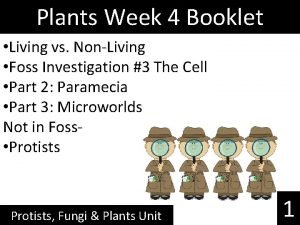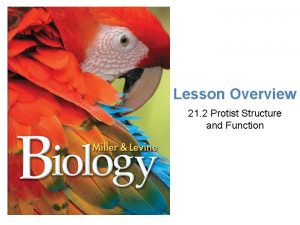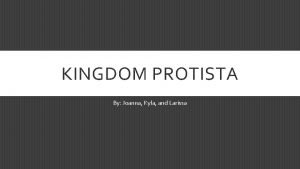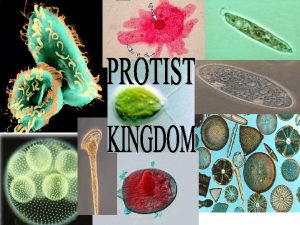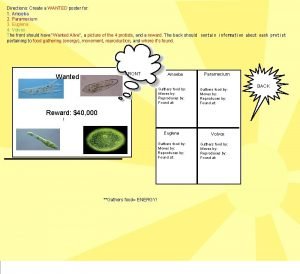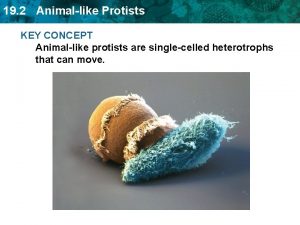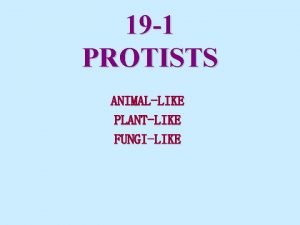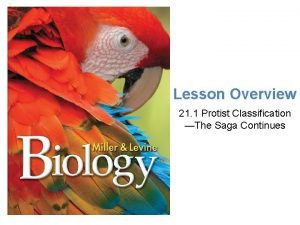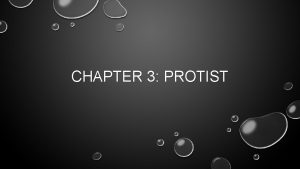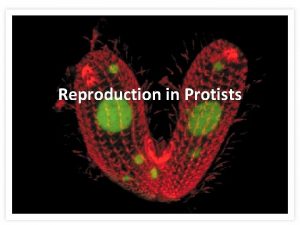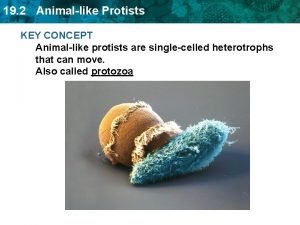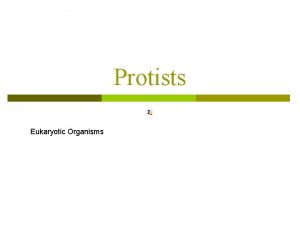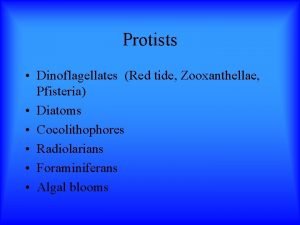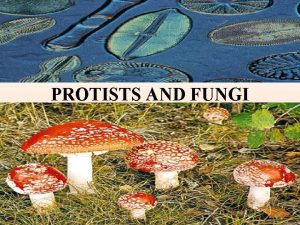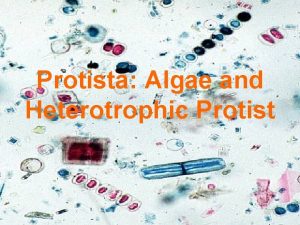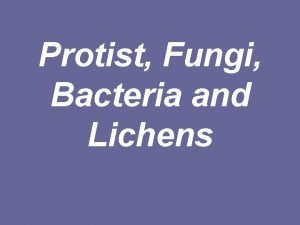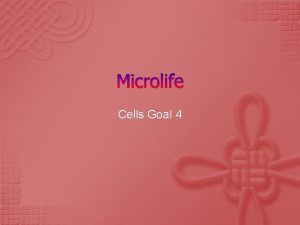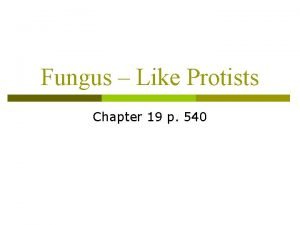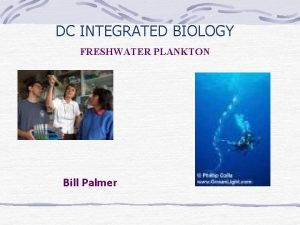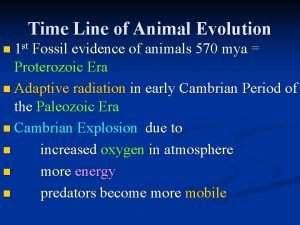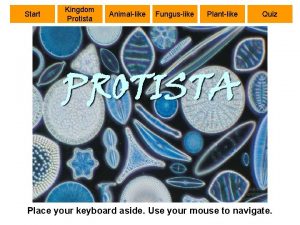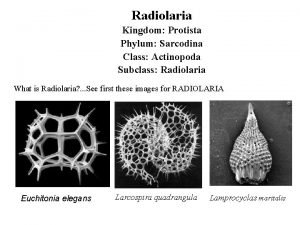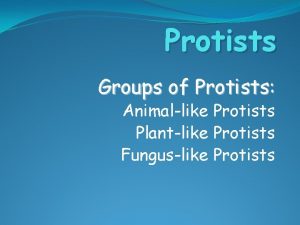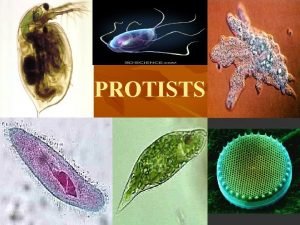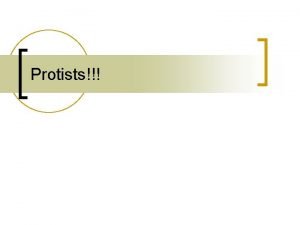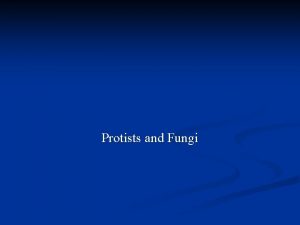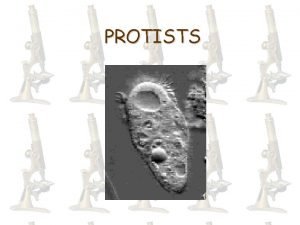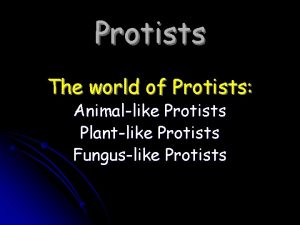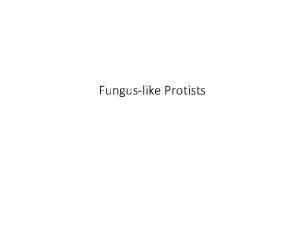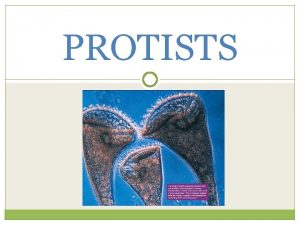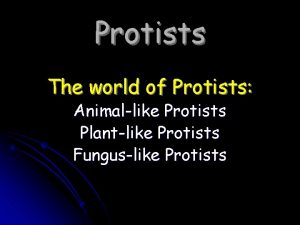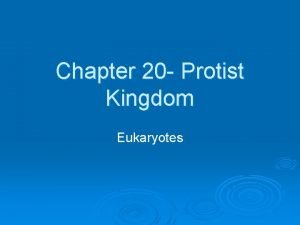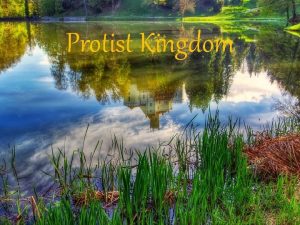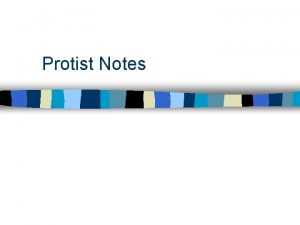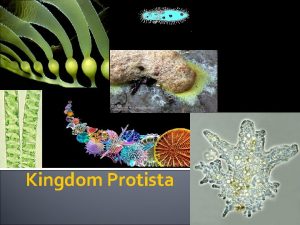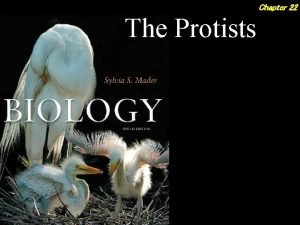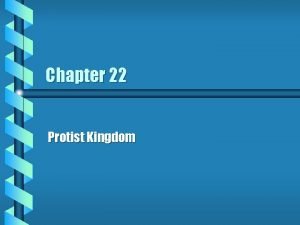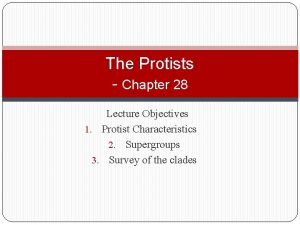Chapter 28 Protists Protist is the informal name











































- Slides: 43

Chapter 28 Protists

• Protist is the informal name of the kingdom of mostly unicellular eukaryotes • Advances in eukaryotic systematics have caused the classification of protists to change significantly • Protists constitute a paraphyletic group, and Protista is no longer valid as a kingdom

Concept 28. 1: Diversity of Single-celled Organisms • Protists are eukaryotes and thus have organelles and complexity than prokaryotes • Most are unicellular, but some are colonial and multicellular species

• Protists, the most structurally and nutritionally diverse of all eukaryotes, include – Photoautotrophs, which contain chloroplasts – Heterotrophs, which absorb or ingest food particles – Mixotrophs, which combine photosynthesis and heterotrophy • Protist habitats are also diverse in habitat • Reproduction and life cycles include sexual and asexual species

Endosymbiosis in Eukaryotic Evolution • There is now considerable evidence that much protist diversity has its origins in endosymbiosis • Endosymbiosis is the process in which a unicellular organism engulfs another cell, which becomes an endosymbiont and then organelle in the host cell • Mitochondria evolved by endosymbiosis of an aerobic prokaryote • Plastids evolved by endosymbiosis of a photosynthetic cyanobacterium


• Our understanding of the relationships among protist groups continues to change rapidly • One hypothesis divides all eukaryotes (including protists) into five supergroups

Concept 28. 2: Excavates include protists with modified mitochondria and protists with unique flagella • The clade Excavata is characterized by its cytoskeleton • Some members have a feeding groove • This controversial group includes the diplomonads, parabasalids, and euglenozoans

• Diplomonads – Have two nuclei and multiple flagella – Derive energy anaerobically, for example, by glycolysis Figure 28. 5 a (a) Giardia intestinalis, a diplomonad (colorized SEM) 5 µm

• Parabasalids include trichomonads – Which move by means of flagella and an undulating part of the plasma membrane Figure 28. 5 b (b) Trichomonas vaginalis, a parabasalid (colorized SEM)

• Euglenozoa is a diverse clade that includes – Predatory heterotrophs, photosynthetic autotrophs, and pathogenic parasites • The main feature that distinguishes protists in this clade – Is the presence of a spiral or crystalline rod of unknown function inside their flagella – This clade includes the kinetoplastids and euglenids Flagella 0. 2 µm Crystalline rod Figure 28. 6 Ring of microtubules

• Kinetoplastids – Have a single, large mitochondrion that contains an organized mass of DNA called a kinetoplast – Include free-living consumers of bacteria in freshwater, marine, and moist terrestrial ecosystems • The parasitic kinetoplastid Trypanosoma – Causes sleeping sickness in humans Figure 28. 7 9 m

• Euglenids, Euglena – Have one or two flagella that emerge from a pocket at one end of the cell Long flagellum Eyespot: pigmented organelle that functions as a light shield, allowing light from only a certain direction to strike the light detector Light detector: swelling near the base of the long flagellum; detects light that is not blocked by the eyespot; as a result, Euglena moves toward light of appropriate intensity, an important adaptation that enhances photosynthesis Short flagellum Euglena (LM) Nucleus Contractile vacuole 5 µm Plasma membrane Figure 28. 8 Pellicle: protein bands beneath the plasma membrane that provide strength and flexibility (Euglena lacks a cell wall) Chloroplast Paramylon granule

Concept 28. 3 Chromalveolates • Some data suggest that the clade Chromalveolata is monophyletic and originated by a secondary endosymbiosis event • The proposed endosymbiont is a red alga • This clade is controversial and includes the alveolates and the stramenopiles

• Members of the clade Alveolata have membrane-bounded sacs (alveoli) just under the plasma membrane • The function of the alveoli is unknown • Alveolata includes the dinoflagellates, apicomplexans, and ciliates

• Dinoflagellates Figure 28. 10 Flagella 3 µm – Are a diverse group of aquatic photoautotrophs and heterotrophs – Are abundant components of both marine and freshwater phytoplankton – Two flagella make them spin as they move through the water

• Rapid growth of some dinoflagellates – Is responsible for causing “red tides, ” which can be toxic to humans, Pfiesteria piscicida

• Apicomplexans, Plasmodium • The apicomplexan Plasmodium is the parasite that causes malaria • Plasmodium requires both mosquitoes and humans to complete its life cycle • Approximately 2 million people die each year from malaria • Efforts are ongoing to develop vaccines that target this pathogen


• Ciliates, a large varied group of protists, Paramecium – Are named for their use of cilia and have a large macronuclei and small micronuclei

• Stramenopiles – Includes several groups of heterotrophs as well as certain groups of algae • Most stramenopiles – Have a “hairy” flagellum paired with a “smooth” flagellum Hairy flagellum Smooth flagellum Figure 28. 13 5 µm

• Diatoms are unicellular algae Figure 28. 15 3 µm – With a unique two-part, glass-like wall of hydrated silica – Accumulations of fossilized diatom walls compose much of the sediments known as diatomaceous earth

• Golden algae – Are named for their color, which results from their yellow and brown carotenoids • The cells of golden algae – Are typically biflagellated, with both flagella attached near one end of the cell • Most golden algae are unicellular – But some are colonial Figure 28. 17 25 µm

• Brown algae, or phaeophytes – Are the largest and most complex algae – Are all multicellular, and most are marine – Include many of the species commonly called seaweeds Blade Stipe Figure 28. 18 Holdfast

• Kelps, or giant seaweeds – Live in deep parts of the ocean Figure 28. 19

• Oomycetes include water molds, white rusts, and downy mildews • They were once considered fungi based on morphological studies • Most oomycetes are decomposers or parasites • Their ecological impact can be great, as in potato blight caused by Phytophthora infestans


Concept 28. 4: Rhizarians • DNA evidence supports Rhizaria as a monophyletic clade • Amoebas move and feed by pseudopodia; some but not all belong to the clade Rhizaria • Rhizarians include forams and radiolarians

• Radiolarians are marine protists – Whose tests are fused into one delicate piece, which is generally made of silica – That phagocytose microorganisms with their pseudopodia • The pseudopodia of radiolarians, known as axopodia – Radiate from the central body Axopodia Figure 28. 23 200 µm

Concept 28. 5 Archaeplastida • Over a billion years ago, a heterotrophic protist acquired a cyanobacterial endosymbiont • The photosynthetic descendants of this ancient protist evolved into red algae and green algae • Archaeplastida is a supergroup used by some scientists and includes red algae, green algae, and land plants

• Red algae (Rhodophyta) are reddish in color – Due to an accessory pigment call phycoerythrin, which masks the green of chlorophyll – Are usually multicellular; the largest are seaweeds – Are the most abundant large algae in coastal waters of the tropics (b) Dulse (Palmaria palmata). This edible species has a “leafy” form. (c) A coralline alga. The cell walls of coralline algae are hardened by calcium carbonate. Some coralline algae are members of the biological communities around coral reefs. Figure 28. 28 a–c (a) Bonnemaisonia hamifera. This red alga has a filamentous form.

• Many seaweeds – Are important commodities for humans – Are harvested for food (a) The seaweed is grown on nets in shallow coastal waters. (b) A worker spreads the harvested seaweed on bamboo screens to dry. Figure 28. 20 a–c (c) Paper-thin, glossy sheets of nori make a mineral-rich wrap for rice, seafood, and vegetables in sushi.

• Green algae – Are named for their grass-green chloroplasts – Are divided into two main groups: chlorophytes and charophyceans (chapter 29) – Are closely related to land plants

• Most chlorophytes – Live in fresh water, although many are marine • Other chlorophytes – Live in damp soil, as symbionts in lichens, or in snow

• Chlorophytes include – Unicellular, colonial, and multicellular forms 20 µm 50 µm (a) Volvox, a colonial freshwater chlorophyte. The colony is a hollow ball whose wall is composed of hundreds or thousands of biflagellated cells (see inset LM) embedded in a gelatinous matrix. The cells are usually connected by strands of cytoplasm; if isolated, these cells cannot reproduce. The large colonies seen here will eventually release the small “daughter” colonies within them (LM). (b) Caulerpa, an intertidal chlorophyte. The branched filaments lack cross-walls and thus are multinucleate. In effect, the thallus is one huge “supercell. ” Figure 28. 30 a–c (c) Ulva, or sea lettuce. This edible seaweed has a multicellular thallus differentiated into leaflike blades and a rootlike holdfast that anchors the alga against turbulent waves and tides.

Concept 28. 6: Unikonts • The supergroup Unikonta includes animals, fungi, and some protists • This group includes two clades: the amoebozoans and the opisthokonts (animals, fungi, and related protists) • The root of the eukaryotic tree remains controversial

• Amoebozoans – Are amoebas that have lobe-shaped, rather than threadlike, pseudopodia – Include gymnamoebas, entamoebas, and slime molds

Concept 28. 7: Protists play key roles in ecological communities • Protists are found in diverse aquatic environments • Protists often play the role of symbiont or producer

Symbiotic Protists • Some protist symbionts benefit their hosts – Dinoflagellates nourish coral polyps that build reefs – Wood-digesting protists digest cellulose in the gut of termites

• Some protists are parasitic – Plasmodium causes malaria – Pfiesteria shumwayae is a dinoflagellate that causes fish kills – Phytophthora ramorum causes sudden oak death

Photosynthetic Protists • Many protists are important producers that obtain energy from the sun • In aquatic environments, photosynthetic protists and prokaryotes are the main producers • In aquatic environments, photosynthetic protists are limited by nutrients • These populations can explode when limiting nutrients are added

Figure 28. 27 Other consumers Herbivorous plankton Carnivorous plankton Prokaryotic producers Protistan producers

Figure 28. UN 06
 Name three line segments
Name three line segments Chapter 19 protists study guide answers
Chapter 19 protists study guide answers Chapter 19 protists worksheet answers
Chapter 19 protists worksheet answers Rhizaria reproduction
Rhizaria reproduction Que es el lenguaje inculto
Que es el lenguaje inculto Rosa rigosa
Rosa rigosa Unknown bacteria
Unknown bacteria Single celled protist
Single celled protist Protoctista characteristics
Protoctista characteristics Protist coloring sheet answer key
Protist coloring sheet answer key What is a plant like protist
What is a plant like protist Protist structure and function
Protist structure and function Protists unicellular or multicellular
Protists unicellular or multicellular Animal like protists
Animal like protists Protist brainpop answers
Protist brainpop answers Protists have nucleus
Protists have nucleus Organelle wanted poster
Organelle wanted poster Animal-like protist
Animal-like protist Pyrrophyta
Pyrrophyta 21.1 protist classification the saga continues
21.1 protist classification the saga continues Protist
Protist Cytoskeletal protein
Cytoskeletal protein Reproduction of protista
Reproduction of protista Isoprene archaea
Isoprene archaea Most wanted bacteria poster
Most wanted bacteria poster Protists
Protists Protist
Protist Amoeba paramecium euglena chlamydomonas
Amoeba paramecium euglena chlamydomonas Pfisteria
Pfisteria Anal pore
Anal pore Protist
Protist Protist
Protist Celula
Celula Type of protist
Type of protist Dominio eukarya reino protista
Dominio eukarya reino protista How do fungus like protists move
How do fungus like protists move Domain eukarya, kingdom plantae
Domain eukarya, kingdom plantae Protist
Protist Characteristics of protista kingdom
Characteristics of protista kingdom Protist evolution
Protist evolution Quiz 2: animal-like protists
Quiz 2: animal-like protists Phylum radiolaria
Phylum radiolaria Protist domain
Protist domain Protist
Protist

